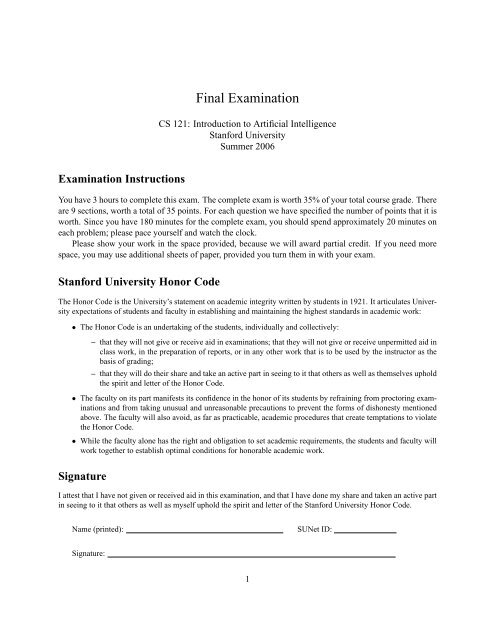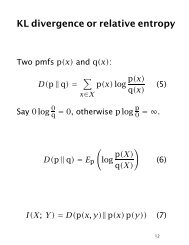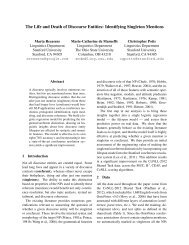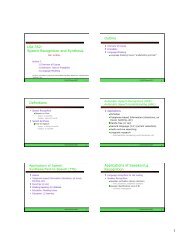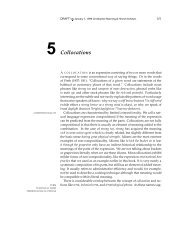practice final exam - The Stanford NLP (Natural Language ...
practice final exam - The Stanford NLP (Natural Language ...
practice final exam - The Stanford NLP (Natural Language ...
Create successful ePaper yourself
Turn your PDF publications into a flip-book with our unique Google optimized e-Paper software.
Examination Instructions<br />
Final Examination<br />
CS 121: Introduction to Artificial Intelligence<br />
<strong>Stanford</strong> University<br />
Summer 2006<br />
You have 3 hours to complete this <strong>exam</strong>. <strong>The</strong> complete <strong>exam</strong> is worth 35% of your total course grade. <strong>The</strong>re<br />
are 9 sections, worth a total of 35 points. For each question we have specified the number of points that it is<br />
worth. Since you have 180 minutes for the complete <strong>exam</strong>, you should spend approximately 20 minutes on<br />
each problem; please pace yourself and watch the clock.<br />
Please show your work in the space provided, because we will award partial credit. If you need more<br />
space, you may use additional sheets of paper, provided you turn them in with your <strong>exam</strong>.<br />
<strong>Stanford</strong> University Honor Code<br />
<strong>The</strong> Honor Code is the University’s statement on academic integrity written by students in 1921. It articulates University<br />
expectations of students and faculty in establishing and maintaining the highest standards in academic work:<br />
• <strong>The</strong> Honor Code is an undertaking of the students, individually and collectively:<br />
– that they will not give or receive aid in <strong>exam</strong>inations; that they will not give or receive unpermitted aid in<br />
class work, in the preparation of reports, or in any other work that is to be used by the instructor as the<br />
basis of grading;<br />
– that they will do their share and take an active part in seeing to it that others as well as themselves uphold<br />
the spirit and letter of the Honor Code.<br />
• <strong>The</strong> faculty on its part manifests its confidence in the honor of its students by refraining from proctoring <strong>exam</strong>inations<br />
and from taking unusual and unreasonable precautions to prevent the forms of dishonesty mentioned<br />
above. <strong>The</strong> faculty will also avoid, as far as practicable, academic procedures that create temptations to violate<br />
the Honor Code.<br />
• While the faculty alone has the right and obligation to set academic requirements, the students and faculty will<br />
work together to establish optimal conditions for honorable academic work.<br />
Signature<br />
I attest that I have not given or received aid in this <strong>exam</strong>ination, and that I have done my share and taken an active part<br />
in seeing to it that others as well as myself uphold the spirit and letter of the <strong>Stanford</strong> University Honor Code.<br />
Name (printed): SUNet ID:<br />
Signature:<br />
1
1. True/False Questions. For each statement circle either TRUE or FALSE. Half credit will be given for statements<br />
that are left completely blank, and thus it is not in your best interest to guess randomly. (0.25 point<br />
each, for a total of 4 points)<br />
1 <strong>The</strong> goal of AI is to design systems that can act like humans. TRUE FALSE<br />
2 <strong>The</strong> Turing test evaluates a system’s ability to act rationally. TRUE FALSE<br />
3 A search problem must name exactly one state as being the goal. TRUE FALSE<br />
4 A finite problem graph can give rise to an infinite search tree with DFS. TRUE FALSE<br />
5 Iterative Deepening Search is a way to make DFS optimal for search<br />
problems with a constant step cost.<br />
6 Greedy hill climbing search is often yields better solutions than simulated<br />
annealing since it is not stochastic.<br />
7 <strong>The</strong> arc-consistency algorithm is only useful if it is run after every<br />
variable assignment in CSP search.<br />
8 <strong>The</strong> minimum remaining values heuristic orders the values to consider<br />
in CSP search.<br />
9 Given a set of variables, the Bayesian network with no arcs corresponds<br />
to one particular probability distribution over those variables.<br />
10 Every variable in a Bayes net is independent of all of its descendents<br />
given its children.<br />
11 Each probability distribution over a set of variables corresponds to a<br />
particular Bayesian network over those variables.<br />
12 A Naive Bayes model requires O(n) parameters, where there are n<br />
features.<br />
13 <strong>The</strong> Naive Bayes assumption is that that the observations are independent<br />
of the class variable.<br />
14 In an HMM, the current observation is independent of previous observations<br />
given the current state.<br />
15 In the HMM filtering task, we look for the most likely state sequence<br />
given a sequence of observations.<br />
TRUE FALSE<br />
TRUE FALSE<br />
TRUE FALSE<br />
TRUE FALSE<br />
TRUE FALSE<br />
TRUE FALSE<br />
TRUE FALSE<br />
TRUE FALSE<br />
TRUE FALSE<br />
TRUE FALSE<br />
TRUE FALSE<br />
16 <strong>The</strong> Bellman equations completely define the value function. TRUE FALSE<br />
17 An MDP can be seen as an HMM with the addition of reward and action<br />
selection nodes.<br />
TRUE FALSE<br />
18 If a sentence α is not satisfiable, then the sentence ¬α is valid. TRUE FALSE<br />
19 If a sentence α is not valid, then the sentence ¬α is satisfiable. TRUE FALSE<br />
20 <strong>The</strong> following inference procedure is sound and complete for FOL:<br />
propositionalize the knowledge base and perform truth table inference.<br />
2<br />
TRUE FALSE
2. Foundations. (2 points)<br />
(a) Briefly describe the Performance, Environment, Actions, and Sensors (PEAS) for an autonomous securities<br />
(e.g., stocks, bonds, etc.) trading agent.<br />
(b) What’s wrong with the term “artificial intelligence” to describe this field?<br />
3
3. Search. (2 points)<br />
(a) Consider the problem of searching from state a to state i in the directed graph above. Begin by tracing<br />
the DFS algorithm, and draw the search tree that results. Assume that the successor function only works<br />
in the direction of the directed arcs. Furthermore, assume that successor states are added to the queue in<br />
alphabetical order (a is added before b). To make the tree clearer, circle nodes when they are pulled off<br />
the queue.<br />
(b) Now trace the behavior of the BFS algorithm, and draw the search tree that results, in the same manner<br />
as above.<br />
4
(c) Now suppose we assume that all path costs are 1, and that we are given the heuristic in the following<br />
table. Run the A* search algorithm.<br />
State h<br />
a 3<br />
b 1<br />
c 1<br />
d 1<br />
e 2<br />
f 2<br />
g 2<br />
h 2<br />
i 0<br />
(d) Is the heuristic admissable?<br />
5
(e) Consider the Towers of Hanoi puzzle shown above. It is an ancient puzzle, consisting of a collection<br />
of rings of different sizes, and three posts mounted on a base. At the beginning all the rings are on the<br />
left-most post as shown above, and the goal is to move them all to the rightmost post, by moving one ring<br />
at a time from one post to another. But, at no time may a larger ring be placed on top of a smaller one.<br />
Formalize the problem of getting from the beginning state to the goal state as a search problem.<br />
6
4. Constraint Satisfaction Problems. (2 points)<br />
(a) Recall the map coloring problem from class. Suppose we’d like to color the map of Western Europe<br />
shown above using only 3 colors: red, green, and blue. Formalize this as a CSP.<br />
7
(b) Suppose France must be colored red. Trace the steps of a single run of the arc-consistency algorithm to<br />
remove inconsistent values from the domains of all the variables. Show your work below.<br />
8
5. Probability and Bayesian Networks. (2 points)<br />
X Y Z P(x, y, z)<br />
true true true 0.018<br />
true true false 0.002<br />
true false true 0.072<br />
true false false 0.008<br />
false true true 0.252<br />
false true false 0.378<br />
false false true 0.108<br />
false false false 0.162<br />
(a) Consider the full joint probability distribution over the variables X, Y , and Z shown above. What’s the<br />
marginal probability distribution P(X)?<br />
(b) Compute the conditional probability tables P(Y |X) and P(Z|X).<br />
(c) Are Z and Y conditionally independent given X?<br />
9
(d) Given your answers to the questions above, design a Bayesian network to represent this joint probability<br />
distribution more compactly.<br />
(e) How many independent parameters does your network have?<br />
10
6. Machine Learning. (2 points)<br />
(a) Suppose we’d like to train a Naive Bayes classifier for a binary classification task. Suppose we have a<br />
binary class variable Happy, and that there are three binary features, Sunny, Weekend, and Productive. Estimate<br />
the parameters of the Naive Bayes model using maximum likelihood estimation from the following<br />
training set:<br />
Sunny Weekend Productive Happy<br />
true true true false<br />
true true false true<br />
true false false true<br />
false true true false<br />
false false true true<br />
false false false false<br />
(b) Compute the probability distribution specified by your learned Naive Bayes model for the Happy variable<br />
for the two test <strong>exam</strong>ples below. What is the most likely value of the Happy variable?<br />
Sunny Weekend Productive Happy<br />
false true false ?<br />
true false true ?<br />
11
(c) Now train the perceptron on the same training set to predict the Happy variable, where we map true to<br />
the feature value 1 and false to the feature value 0. Don’t forget to add a bias feature! Do one epoch of<br />
training, with α = 1. Show your work, and the <strong>final</strong> weight vector.<br />
(d) Compute the scores assigned to the two possible values of the variable Happy for the <strong>exam</strong>ples in the test<br />
set. What value does it select?<br />
12
7. Hidden Markov Models. (2 points)<br />
(a) Suppose we are developing software to track airplanes using blips observed on a radar screen. In particular,<br />
radar is a noisy sensing device, which reports radio waves that bounce off of objects in the sky. When<br />
objects are present, they usually (but not always) reflect the waves, and a blip shows up on the screen<br />
in the approximate location. <strong>The</strong> radar sensor rotates around a central axis to pick up readings in every<br />
direction, and it makes a full rotation every 10 seconds. Thus the blips on the screen are updated every 10<br />
seconds. Assuming we can discretize the sensable space around us into a 1000x1000 matrix, formalize<br />
the relationship between the airplane locations and the blips on the radar screen as an HMM.<br />
(b) What algorithm would you use to maintain the best possible estimates of the current airplane positions,<br />
given the noisy evidence?<br />
13
(c) Suppose we are given the following HMM designed to extract animal names from tokenized text, where<br />
each hidden state Xt can take on the values background or animal, and where the evidence variables<br />
Et can take on the value of any token (word or punctuation) in the vocabulary. Here are the HMM<br />
parameters:<br />
Starting Distribution<br />
P(X0 = background) P(X0 = animal)<br />
0.9 0.1<br />
Transition Model<br />
Xt−1 P(Xt = background|Xt−1) P(Xt = animal|Xt−1)<br />
background 0.9 0.1<br />
animal 0.5 0.5<br />
Emission Model<br />
Xt<br />
P(Et)<br />
a chuck could how much wood<br />
background 0.2 0.1 0.2 0.2 0.2 0.1<br />
animal 0.1 0.3 0.1 0.1 0.1 0.3<br />
(d) Compute the most likely sequence of states corresponding to the following input sequence. Show the<br />
trellis diagram you used in the computation. Did the HMM successfully label the words “wood chuck”<br />
as an animal name?<br />
how much wood could a wood chuck chuck<br />
14
8. Markov Decision Processes and Reinforcement Learning. (2 points)<br />
(a) Suppose you are given a simple 3 state MDP, specified with the following transition function T and reward<br />
function R. Run the value iteration algorithm until the policy converges in the table provided below. Use<br />
the discount factor γ = 0.5. When choosing the maximum valued action for each state, break ties by<br />
choosing left before right.<br />
Reward Function<br />
S R(S)<br />
a 2<br />
b 4<br />
c -10<br />
Transition Model<br />
St−1 At−1 P(St = a|St−1, At−1) P(St = b|St−1, At−1) P(St = c|St−1, At−1)<br />
a left 0 0.2 0.8<br />
a right 0 0.8 0.2<br />
b left 0.8 0 0.2<br />
b right 0.2 0 0.8<br />
c left 0.2 0.8 0<br />
c right 0.8 0.2 0<br />
Value Iteration Table<br />
Iteration U(a) U(b) U(c) π(a) π(b) π(c)<br />
1 0 0 0 left left left<br />
2<br />
3<br />
4<br />
5<br />
6<br />
7<br />
15
(b) Remember the demo we saw in class of a simulated robot learning to locomote along a line with a single<br />
arm (that could rotate around an axis, and bend in one place). Formalize the robot’s environment/task<br />
as an MDP. You can assume that we can discretize the angular positions of the two arm joints. What is<br />
the state space? What is the reward function? What are the possible actions, and what is the transition<br />
function?<br />
16
9. Logic. (2 points)<br />
(a) Use a truth table to prove whether the following propositional logic sentence is valid, satisfiable, or<br />
unsatisfiable:<br />
(p ∧ (p → q) ∧ (q → r)) ↔ (q ∧ r)<br />
(b) Write down first order logic representations of the following English sentences. Use this set of predicates:<br />
IsStudentOf, IsSmart, IsAdvisor, GetsJob.<br />
Anna is a student of Bill.<br />
All students of a smart advisor are smart.<br />
Bill is smart.<br />
Smart students get jobs.<br />
17
(c) Now propositionalize the first order logic sentences you came up with above. How many propositions<br />
result?<br />
(d) Suppose we wanted to find out whether the following propositionalized sentence is entailed by the other<br />
propositionalized sentences above. If we used truth table inference, how many rows would the truth table<br />
have?<br />
GetsJob(Anna)<br />
(e) Use the propositional forward chaining algorithm instead, with the modus ponens rule, to show that the<br />
sentence is entailed.<br />
18


